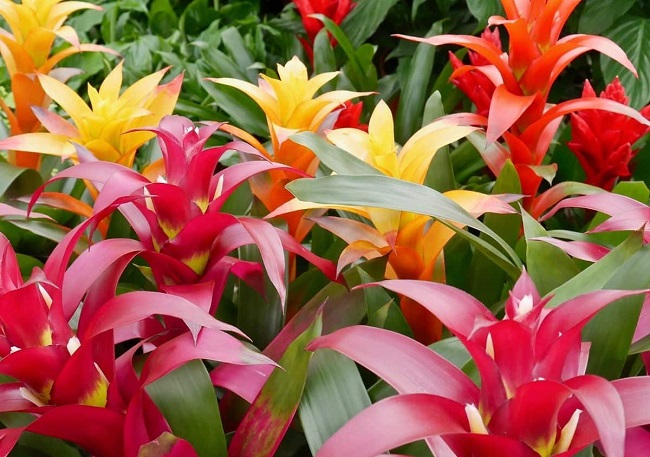
Guzmania is a striking tropical plant renowned for its vibrant colors and unique appearance. Belonging to the Bromeliaceae family, Guzmania species are native to the rainforests of Central and South America. In this article, we will explore the native habitat of Guzmania and provide instructions for successfully growing this stunning plant in both garden and indoor settings, including homes and greenhouses.
Native Habitat of Guzmania
Guzmania plants are primarily found in the lush rainforests of Central and South America, spanning countries such as Costa Rica, Ecuador, and Brazil. They are epiphytic plants, meaning they naturally grow on the branches of trees rather than in soil. In their native habitat, Guzmania species thrive in warm, humid environments with filtered or indirect light. They often form part of the diverse understory vegetation, nestled among the shade-providing canopy trees.
Growing Guzmania in the Garden
Climate and Sunlight
Guzmania plants prefer warm climates and thrive in temperatures between 60°F and 80°F. Choose a location in your garden that offers bright, indirect light or filtered sunlight. Avoid direct sunlight, as it can scorch the leaves.
Soil and Potting
Guzmania plants are epiphytic, so they don’t require soil. Instead, they can be grown directly on tree branches, in moss, or in a well-draining potting mix specifically formulated for epiphytic plants. If you are growing Guzmania in a pot, use a mix of orchid bark, sphagnum moss, and perlite to ensure proper drainage.
Watering and Humidity
Guzmania plants thrive in humid environments. Mimic their native habitat by providing consistent humidity levels. Water the plant’s central cup (the central rosette of leaves) regularly, ensuring it remains filled with clean water. Mist the leaves occasionally to maintain humidity.
Fertilization
Use a balanced, water-soluble fertilizer diluted to half-strength once a month during the growing season (spring and summer). Avoid fertilizing during the winter months when Guzmania plants are generally dormant.
Growing Guzmania Indoors or in a Greenhouse
Light and Temperature
Place your Guzmania plant near a bright, indirect light source, such as a north or east-facing window, to ensure adequate light for growth. Maintain a temperature range of 60°F to 75°F to provide the ideal conditions for Guzmania.
Humidity and Watering
Indoor environments are often drier than the natural rainforest habitat of Guzmania. Increase humidity levels by placing the plant on a humidity tray or using a room humidifier. Water the central cup of the plant regularly, ensuring it doesn’t dry out completely. Check the moisture level of the potting mix and water when the top inch feels dry.
Potting and Soil
Use a well-draining potting mix suitable for epiphytic plants, such as a mixture of orchid bark, sphagnum moss, and perlite. Repot the Guzmania plant when it outgrows its container or when the potting mix becomes too compacted.
Fertilization
Feed the plant with a diluted, water-soluble fertilizer specifically formulated for bromeliads once a month during the growing season. Dilute the fertilizer to half-strength to avoid overfeeding and potential damage to the plant.
Conclusion
Guzmania plants bring an exotic touch to any garden or indoor space with their vibrant colors and unique forms. By understanding the native habitat of Guzmania and replicating its ideal growing conditions, you can enjoy the beauty of this tropical plant in your garden or home. Whether you choose to grow Guzmania outdoors or in a controlled environment like a greenhouse, providing proper lighting, humidity, and appropriate potting mix will help your Guzmania thrive and become a captivating addition to your botanical collection.
10 Fun Facts About Guzmania
Bromeliad Family
Guzmania belongs to the Bromeliaceae family, which also includes other popular houseplants such as pineapple and air plants (Tillandsia).
Colorful Bracts
Guzmania plants are known for their stunning and vibrant bracts, which are leaf-like structures that surround the actual flowers. The bracts can display a wide range of colors, including shades of red, orange, yellow, pink, and purple.
Epiphytic Nature
Like many other bromeliads, Guzmania plants are epiphytic, meaning they naturally grow on trees or other surfaces in their native rainforest habitat. They absorb moisture and nutrients from the air and rainwater, rather than relying on soil.
Central Cup
Guzmania plants have a central cup or reservoir formed by the arrangement of their leaves. This cup collects water, which provides hydration for the plant and acts as a habitat for small organisms like frogs and insects.
Humidity Indicators
The health of a Guzmania plant can serve as an indicator of the humidity levels in its environment. If the leaves start to curl or become brown at the edges, it may suggest that the air is too dry, and increasing humidity would benefit the plant.
Long-Lasting Blooms
Guzmania plants typically have long-lasting blooms. The colorful bracts can remain vibrant for several weeks, providing an extended period of beauty and visual interest.
Indoor Air Purifiers
Like other bromeliads, Guzmania plants are known for their air-purifying qualities. They can effectively remove toxins such as formaldehyde and benzene from indoor environments, improving the air quality in your home or office.
Attracting Birds and Insects
The bright and showy bracts of Guzmania plants often attract birds, butterflies, and bees, making them beneficial for pollinators in their native habitats.
Hybrid Varieties
There are numerous hybrid varieties of Guzmania available, resulting in a wide array of colors, patterns, and sizes. These hybrids are often bred for specific traits, such as larger bracts or unique foliage patterns.
Low-Maintenance Plants
Guzmania plants are generally considered low-maintenance houseplants. They have relatively simple care requirements and can adapt well to indoor environments, making them suitable for both beginner and experienced plant enthusiasts.
Related Articles & Free Email Newsletter Sign Up
Daffodils: Delighting Your Yard and Garden with Radiant Beauty
How to Grow & Care for the Lipstick Plant




Comment here